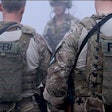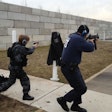The brutal murders of four veteran Oakland police officers on last March 21 shook the entire nation's law enforcement to its very core. It was the worst mass killing of California officers since the 1970 Newhall shootout when four CHP officers were murdered.
I live in the Oakland-San Francisco Bay Area, and watched as the horrifying events unfolded on live TV. And I watched again as the OPD memorialized its four fallen officers at the largest funeral in Oakland history.
I also watched the coverage of the events that preceded the March murders.
You see, Oakland was already a city reeling from the controversial BART Police shooting on New Year's Eve. That shooting touched off a series of violent protests, turned riots, in downtown Oakland.
That was followed by the deadliest day in Oakland police history when four experienced, veteran officers, two of them SWAT sergeants, were shot and killed and a third SWAT sergeant was shot and wounded by a lone gunman.
Like all other officers-both retired and active who lived in the Bay Area at the time-I could only voice one question: How could such an unthinkably horrific tragedy happen?
OPD and its interim chief sought the answer. They turned to an outside board of inquiry made up of respected, experienced LE experts.
The report's findings and recommendations were released to the public last week. Not surprisingly, this report stirred up a lot of emotion and controversy.
I highly recommend that everyone in LE thoroughly read the Oakland Police Shootings after-action report. You can access the entire public report here by clicking onto POLICE Magazine Editor David Griffith's informative, insightful blog on the after-action report.
There, you'll also be able to access the Oakland Police radio transmissions from March 21, 2009. They are in a word, riveting.
I also very highly recommend you read Police Magazine associate editor (Los Angeles Sheriff's Department retired) Dean Scoville's thought-provoking May 2009 feature article "What Can Be Learned from the Oakland Tragedy." He asks some of the very questions that the after-action report answers. And although no one who was involved in the incident and no one from the Oakland police would consent to an interview, Dean's article is better than 90 percent accurate when compared with the official after-action report.
I watched the tragic events unfold on live TV, along with the aftermath, including the many news conferences. I've also read countless newspaper articles, and watched (from afar) as the Oakland Police Department valiantly works toward recovering from this unthinkable tragedy.
I watched as OPD SWAT went into "stand down" mode for two months, with the Alameda County Sheriff's tactical team handling all SWAT assignments in Oakland. In October I was privileged to be an observer at Urban Shield, a 48-hour SWAT competition sponsored and organized by Alameda County SD. The fierce competition was won by Oakland SWAT. OPD's healing process continued.
Then came the after-action report, and I watched new Oakland Police Chief Anthony Batts' news conference. What he said was very telling, especially since he's a former Long Beach PD SWAT Team Leader: "I concur with all the [report's] findings".
Acting on the report's findings, an OPD Captain and Lieutenant have been notified of their demotions [two ranks]. And an OPD deputy chief decided to retire early rather than be demoted. The attorney for the lieutenant and captain says they will contest the demotions.
The report is not all negative and gives credit where it's due. It cites the bravery of many OPD officers, among the 115 police units who responded to the events of that fateful day.
Conversely, the report is highly critical of a number of OPD officer actions. From the initial traffic stop to the SWAT entry into the apartment, the report cited a number of tactical mistakes and faulty decisions.
I have a standing rule of not passing judgment - until/unless I know all the pertinent facts. I wasn't there or directly involved in the events of March 21, nor do I have firsthand knowledge of what happened or why.
I only know what I've seen, read, and heard-which is essentially second-hand. The closest I've come to "knowing" is via the after-action report. Anything else would be pure guessing or speculation on my part.
There are far too many "armchair quarterbacks" who [mistakenly] think "Monday morning quarterbacking is acceptable. It's not.
The next best thing to being there are closed door briefings from the participants. Debriefings are the time-honored method of learning who, what, when, where how, and why things happened along with lessons learned for the "next" time. Because there's always a "next" time.
I'm certain all of us in LE, especially SWAT, have questions about what happened on March 21, with an eye for how we would or should handle something similar if it happened to us.
And that is one of the benefits of the Oakland after-action report, that we learn from the experts' analysis, findings, and recommendations. Yet, there are lingering questions that are left unanswered. These are the questions that would undoubtedly be asked during a debrief:
- Why did the two motor officers both approach the suspect's vehicle together?
- Why did it take 90 minutes into the incident to initiate an official SWAT callout?
- Why was there no official incident command or command post established?
- What is OPD protocol or policy for who is in command of critical incidents?
- What is OPD protocol or policy for who is in command of SWAT, especially tactical operations.
- Why was [dynamic] entry the only option seriously considered? The report says there was "no compelling reason" to make dynamic entry.
- Why wasn't the target location scouted and innocents evacuated?
- Was a floor plan available?
- Why was the entry briefing held so close to the target location?
- Why weren't there any emergency medical personnel [particularly SWAT medics] on hand when entry was made?
The answers to these, and other, important questions need to be answered. And the ones who deserve the answers most are the members of the Oakland Police Department-especially the SWAT team.
To OPD's credit, they're initiating a second outside tactical review/analysis of the March 21 tragedy. This second review will be performed by the California Association of Tactical Officers (CATO), a highly respected, professional tactical association of experienced SWAT officers. OPD and all of SWAT will benefit greatly from the two outside reviews.
I highly recommend that all SWAT or tactical teams conduct their own debriefings on the Oakland shootings. Put your team to work, gathering all available intel from as many sources as possible.
Start with the OPD board of inquiry after-action report and definitely include the OPD radio transmissions from March 21. Follow up on these by reading as many news and LE articles, blogs, commentaries that you can find, especially via the Internet. And if you have access to any "inside intel," that's better yet.
Once you've gathered and analyzed the intel, establish a formal training day to conduct an "Oakland debriefing" for your entire team. Conduct it the same as you would any debriefing of your own. The entire team participates, listens to the [riveting] radio transmissions, watches available news video, reads articles and blogs, and familiarizes themselves with the after-action report.
Then have an open and honest discussion about what happened in Oakland. Make it a learning experience, and apply the lessons to your agency, team, and yourselves. That is the best way to honor the memories of the four courageous fallen Oakland officers.
As Oakland PD continues to recover from the March 21, 2009, tragedy, one thing is certain: They will never forget. Nor should the rest of us.
















